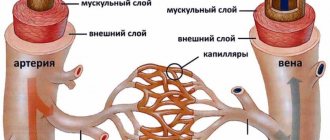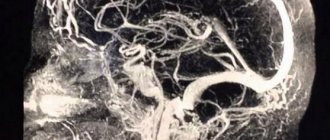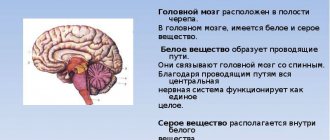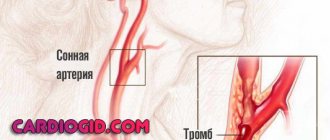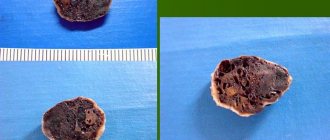Angioencephalopathy is a vascular pathology in which brain activity is disrupted due to constant poor circulation. The prevalence of this disease among the population is 5%.
Among vascular disorders of the brain, this disease occupies one of the first places. Mostly adults are at risk. Hypertensive angioencephalopathy of the brain is diagnosed mainly in people over forty years of age. The disease is more likely to occur in people with significant mental stress.
Unlike stroke and other related diseases, this pathology does not manifest as an acute condition. The basis for the ontogenesis of encephalopathy is prolonged oxygen starvation of brain tissue.
Treatment of encephalopathy
Treatment of encephalopathy is based on treating the underlying disease that led to brain damage, as well as eliminating its symptoms.
Typically, drugs are used that prevent the development of seizures, improve blood supply to the brain and reduce intracranial pressure.
Among the newest treatment methods:
- Intradermal administration of vascular drugs that have a long period of action. They reduce dizziness and headaches.
- Electroneurostimulation “Cefaly” is stimulation of deep brain structures using electromagnetic impulses. This method allows you to relieve the patient from depression and anxiety, and effectively treats chronic and acute headaches.
- Carboxytherapy - a small amount of carbon dioxide is injected subcutaneously, which leads to dilation of blood vessels at the injection site, which can significantly improve blood circulation, reduce pain in the neck and back of the head, relaxes the back muscles, and reduces tinnitus.
- Botulinum therapy with Botox and Dysport helps to effectively treat various types of headaches.
Additional methods in the treatment of this disease are: breathing exercises, reflexology and physiotherapy.
Encephalopathy of the brain in adults
General information about cerebral encephalopathy
The set of symptoms that occur as a result of the death of neurons in the brain is called encephalopathy. This happens due to poisoning, cessation of blood flow or lack of oxygen, which arise due to the presence of a pathological condition or various diseases.
Encephalopathy is divided into types depending on the period in which it arose.
It can be either congenital, resulting from the death of brain cells in the fetus due to a violation of intrauterine development, or acquired, resulting from the influence of various diseases and other pathologies acquired after birth.
Congenital encephalopathy of the brain
The appearance of congenital encephalopathy occurs due to various malformations of the central nervous system, as well as changes in metabolic processes due to genetic failures. In addition, congenital encephalopathy can begin if the child is exposed to a variety of injuries, such as birth injuries to the brain or hypoxia.
The acquisition of encephalopathy after birth occurs due to the impact of a number of damaging factors on the brain. Most often, encephalopathy develops at a fairly low speed, but sometimes it can appear suddenly, for example, with the malignant progression of hypertension or severe kidney damage.
Encephalopathy together with chronic ischemia are among the most common vascular diseases of the human brain. Because of these diseases, brain stroke most often occurs. As a result, a huge number of people die and become disabled every year. Due to encephalopathy, the quality of life suffers greatly and the body’s performance decreases. We can conclude that prevention together with treatment are one of the primary tasks of medicine and are of great importance.
Our specialists
Tarasova Svetlana Vitalievna
Expert No. 1 in the treatment of headaches and migraines. Head of the Center for the Treatment of Pain and Multiple Sclerosis.
Somnologist.
Epileptologist. Botulinum therapist. The doctor is a neurologist of the highest category. Physiotherapist. Doctor of Medical Sciences.
Experience: 23 years.Derevianko Leonid Sergeevich
Head of the Center for Diagnostics and Treatment of Sleep Disorders.
The doctor is a neurologist of the highest category. Vertebrologist. Somnologist. Epileptologist. Botulinum therapist. Physiotherapist. Experience: 23 years.
Palagin Maxim Anatolievich
The doctor is a neurologist. Somnologist. Epileptologist. Botulinum therapist. Physiotherapist. Experience: 6 years.
Romanova Tatyana Alexandrovna
Pediatric neurologist. Experience: 24 years.
Temina Lyudmila Borisovna
Pediatric neurologist of the highest category. Candidate of Medical Sciences.
Experience: 46 years.
Zhuravleva Nadezhda Vladimirovna
Head of the center for diagnosis and treatment of myasthenia gravis.
The doctor is a neurologist of the highest category. Physiotherapist. Experience: 16 years.
Mizonov Sergey Vladimirovich
The doctor is a neurologist. Chiropractor. Osteopath. Physiotherapist. Experience: 8 years.
Bezgina Elena Vladimirovna
The doctor is a neurologist of the highest category. Botulinum therapist. Physiotherapist. Experience: 24 years.
Drozdova Lyubov Vladimirovna
The doctor is a neurologist. Vertebroneurologist. Ozone therapist. Physiotherapist. Experience: 17 years.
Treatment tactics
Treatment of organic brain damage can be very diverse and depends on the pathogenetic mechanism of development of the damage and the immediate cause.
Treatment of organic brain damage can be surgical and conservative. For example, the development of high intracranial pressure, which poses a threat to life, can be treated both surgically and conservatively. Surgical treatment - the application of a burr hole for brain decompression is applicable in the formation of a severe hematoma due to trauma or hemorrhagic stroke, and conservative therapy is possible with a moderate increase in intracranial pressure without brain dislocation. For conservative therapy, diuretics are used that cause forced diuresis, allowing for the rapid elimination of edema.
Treatment of cerebral artery atherosclerosis can also be either surgical or conservative. Surgical – angiography with the installation of stents to widen the lumen of the arteries. Conservative – antithrombotic therapy and correction of dyslepidemia.
Read also
Vegetative-vascular dystonia
Vegetative-vascular dystonia is a dysregulation of the autonomic nervous system, which manifests itself in the form of various clinical symptoms.
This disease is diagnosed at different times… Read more
Atherosclerosis
What is atherosclerosis Atherosclerosis is a narrowing of the arteries caused by the formation of plaque. As a person gets older, fat and cholesterol can accumulate in the arteries and form plaque. Accumulation…
More details
Transient ischemic attack (TIA)
What it is? Why is this happening? Is this condition dangerous? What to do if doctors make such a diagnosis? These questions are always asked by patients who come to see a neurologist. According to classification...
More details
Hemorrhagic stroke
Hemorrhagic stroke is a type of acute cerebrovascular accident, which is characterized by the effusion of blood into the brain substance with the development of neurological deficit, often leading...
More details
Swelling of the legs
Causes of Swelling in the Legs The legs are common sites for swelling due to the effect of gravity on the fluids in the human body. However, fluid retention is not the only cause of leg swelling. Injuries...
More details
A brief excursion into the anatomy of the central nervous system
The human brain is a complex organ responsible for the functioning of the entire organism. There is a clear hierarchy in the structure of the brain, which allows the entire body to work effectively. The central nervous system can be divided into several main parts:
- The cerebral cortex is responsible for higher nervous activity, i.e. thought processes, speech, memory, writing, hearing and many other functions.
- Subcortical structures that form the midbrain. The midbrain is responsible for the primary reflex units and the formation of unconditioned reflexes.
- The bridge is a connecting link between all parts of the central nervous system and the cerebral cortex.
- Cerebellum. It is located in the lower occipital part of the head and is responsible for human coordination in space.
- The medulla oblongata connects the brain with the spinal cord and is its continuation. The medulla oblongata contains vital centers: vasomotor and respiratory.
Etiology
What can cause angioencephalopathy of the brain? The causes of chronic circulatory disorders in the brain and, say, in the heart or lungs are the same. There are two main etiological factors: - vascular atherosclerosis; - increased blood pressure.
They often occur simultaneously and aggravate each other. In addition, other diseases of the heart and blood vessels, such as arrhythmia and chronic heart failure, also affect cerebral circulation. Of particular importance is the presence of vascular malformation in the brain, neck or great vessels. They may not manifest themselves for a long time until another systemic disease develops. A secondary role in the depletion of cerebral circulation is played by compression of large vessels, as well as a sharp decrease in pressure, especially in older people.
Storage diseases can also be the reasons due to which angioencephalopathy of the brain develops. What it is? These are conditions when certain specific substances accumulate in cells due to a pathological process: proteins, fats or carbohydrates.
In this case, vascular amyloidosis occurs in older people, which leads to degenerative changes in their walls. Endocrine diseases also have a certain weight. For example, micro- and macroantiopathies in diabetes mellitus cause chronic cerebral ischemia. Systemic disorders lead to similar consequences: rheumatism, vasculitis, blood diseases.
As a rule, it is not possible to single out any one factor, so the disease is considered polyetiological. The doctor pays attention to the presence of main factors, and considers all concomitant pathologies as additional ones.
Diet
The patient's nutrition should be aimed at improving the water-salt balance. Foods that cause fluid accumulation should be excluded from the diet. Instead, vegetables and fruits, steamed meat, and cereals are introduced into the menu.
It is important to lead a healthy lifestyle, exercise with moderate exercise, and walk a lot. Following these recommendations will help maintain the patient's mental and mental fitness.
Dropsy is a serious disease that does not go away on its own. The patient requires qualified specialist assistance for life. The disease is in an advanced stage and cannot be treated.
Epidemiology
Due to the non-specific nature of complaints, clinical manifestations and changes identified during neuroimaging, it is quite difficult to collect statistical data. To some extent, the prevalence of angioencephalopathy can be judged by the number of strokes. About half a million cases of this acute condition are registered in Russia every year.
Experts emphasize that cognitive disorders, impaired cognitive functions and the incidence of chronic cerebral circulatory failure are of particular importance in identifying dyscirculatory diseases of the brain. But this does not show the true picture of the prevalence of the disease.
What is the danger of the disease?
The consequences of dropsy largely depend on the age at which the disorders occurred and the development of complications:
- Infants experience high excitability, sleep disturbances, and increased muscle tone. The most severe manifestation is developmental delay and mental deviations.
- Preschoolers show aggression, stutter, develop strabismus, and experience developmental delays.
- School-age children experience memory loss and headaches. The learning process is difficult.
- In adults, epilepsy, increased excitability, and hallucinations appear.
The danger of the disease in adulthood is the development of mental disorders, motor functions and motor skills. If urgent measures are not taken, the patient becomes disabled.
Possible complications
Patients with angioencephalopathy must be prescribed background therapy with antiplatelet medications to stabilize blood pressure. Untimely treatment of vascular pathologies of the brain can lead to complications such as oxygen starvation, disruption of the integrity of blood vessels and hemorrhage. Over time, such patients develop fits of laughter, followed by hysteria. There is a coordination disorder and manifestations of oral automatism. Against the background of damage to the occipital zone of the brain, a decrease in vision and even its complete loss cannot be ruled out.
How to treat dropsy?
This brain pathology is practically incurable. Existing medications are designed only to slow down the process.
The most effective treatment method today is surgical, when the patient undergoes bypass surgery or endoscopic surgery.
Massage plays an important role in the treatment of hydrocephalus. Dropsy helps to increase muscle tone, and stroking and rubbing movements have a relaxing effect, helping to restore motor functions.
Another type of treatment, manual therapy, is used as an addition to the use of medications. Manual influence is aimed at activating the human body’s own reserves. The use of manual therapy for secondary dropsy is especially effective.
Recommendations for the use of treatment methods are given by a neurologist or neurosurgeon.
Diagnostics
As in the case of any other disease, a neurologist must collect a complete history of life and illness in order to determine the rate of progression of symptoms and the presence of concomitant somatic pathologies. Then conduct a physical examination: count the pulse and measure blood pressure, listen to heart sounds, blood flow in the large arteries of the upper half of the body. Then carry out neurological tests.
The next stage is laboratory diagnostics. This helps to clarify the cause of angioencephalopathy. The patient is asked to take a clinical blood test, blood biochemistry and a blood test for coagulation and glucose levels. Then it goes through neuroimaging: computed tomography (CT), magnetic resonance imaging (MRI), electroencephalography (EEG). All this makes it possible to determine the level of cerebral circulation and identify areas of pathology. Additionally, electrocardiography (ECG) and ultrasound may be prescribed to confirm diseases of the cardiovascular system.
Folk remedies
Some elderly patients believe that they should not “poison” themselves with pills, but need to look for other ways. Angioencephalopathy of the brain can manifest itself in such paradoxical thinking. Treatment with folk remedies is not welcomed among doctors, as it provokes aggravation of symptoms.
Alternative medicine specialists recommend using the roots of Madder and Caucasian hellebore, the stems of the marsh cinquefoil, the “Magic Trio” balm, tinctures of garlic and cranberries and much more to improve cerebral circulation. The effectiveness of these elixirs is very doubtful, so you should not get carried away with such experiments. Better go to a competent doctor.
Causes
Development factors are different. Among the possible:
- Past severe infectious processes. Especially affecting the brain. It is this disorder that often becomes a trigger, a trigger for amyloidosis. The immune system begins to react inadequately to imaginary stimuli.
- Cardiovascular pathologies. Already named hypertension or symptomatic increase in blood pressure.
- Diabetes. The real scourge of patients with this diagnosis is problems with vessels of various sizes throughout the body. In addition, it may be influenced by other hormonal diseases. Like pathologies of the thyroid gland, adrenal glands.
- Smoking, alcoholism. Bad habits.
- Also excessive physical activity.
- Genetic disorders.
- Malfunctions of the immune system. Against the background of other disorders or as a primary deviation, which rarely happens.
Microangiopathy of cerebral vessels can be polyetiological, that is, due to a group of reasons. All of them are taken into account to determine the path of fundamental treatment.
Stages
There are three stages of angioencephalopathy:
- Subjective complaints about deterioration of memory and attention are accompanied by minor focal symptoms: a decrease in the pupillary reflex, the appearance of mild reflexes of oral automatism. Slight changes in gait, lack of self-confidence, irritability.
- At this stage, neurological symptoms increase and one dominant symptom crystallizes. These may be extrapyramidal disorders, pseudobulbar syndrome, ataxia, dysfunction of the cranial nerves. Cognitive function suffers more severely, and professional and social adaptation decreases.
- Several syndromes predominate in patients. Noteworthy are gross gait disturbances, cerebellar disorders, parkinsonism, and disruption of the pelvic organs. At this stage, criticism of one’s condition decreases and there may be no complaints at all. Patients become helpless, like children, because they develop dementia.
Which doctor should I contact?
Hydrops is treated by neurosurgeons. When you contact the RAS clinic in Moscow, you will be provided with qualified, effective assistance: they will conduct an examination, prescribe tests, make a diagnosis, and determine an effective treatment strategy.
If any symptoms of neurological diseases appear, you must immediately make an appointment with a neurologist to prevent the situation from worsening. We invite you to a consultation with a neurologist in Moscow at the Central Clinical Hospital of the Russian Academy of Sciences. Registration can be made by phone or using the feedback form on the website.
